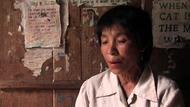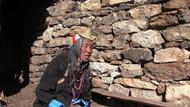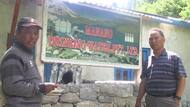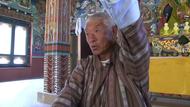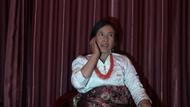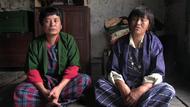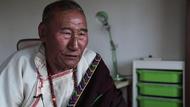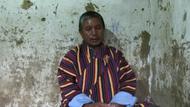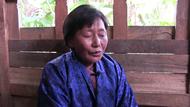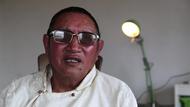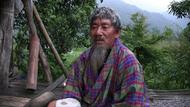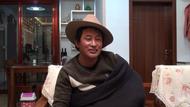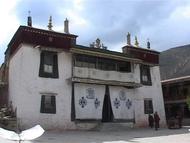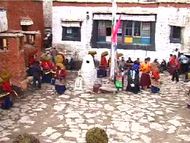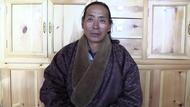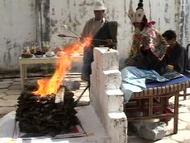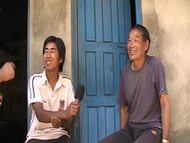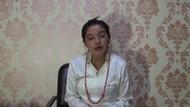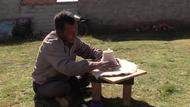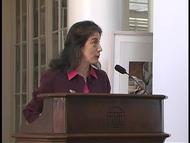Video Overview
Tsering Gyalpo discusses how Tibetans apply regional titles to themselves and discusses regional distinctions in Tibet.
- Lhasa
- Kham
- Amdo
- Kongpo
- Ngari
- Dakpo
- Kailash
- The Hor States
- Nakchu
- Ngawa
- Ladakh
- Puhreng
- Gar
- Gartsé
- Rutok
- Sharpa
- Lhokha
- Nepal
- Dölpo
- Tamang
- Pakistan
- Zangkar
- Kandzé
- Rongpa
- China
- India
- Lo Mentang
- Assam
- Tibet Autonomous Region
- Zhikatsé
- Chamdo
- Degé
- ད་འདི་བོད་ཟེར་ཡ་ཞིག་ཡོད་རེད་པཱ།Now, this saying of "Bod" [Tibet]
- ད་ལྟ་ང་ཚོའི་བོད་ཡིག་དེ་དང་པོ་ད་ཟེར་ཡ་བྱེད་ན།Now if we consider the first saying of our "Bod yik" [Tibetan script],
- བོད་ཟེར་ཡ་འདི་་་This "Bod"...
- བོད་ཡིག་འདི་ཐོན་མི་སཾབྷོ་ཊས་བཟོས་པ་ཡིན་ཙང་།because Tonmi Sambhota created the Tibetan script,
- ཨ་ནི།so,
- ད་ཐོན་མི་སཾབྷོ་ཊ་ནས་འགོ་ཚུགས་བྱས།beginning from Tonmi Sambhota,
- བཙན་པོའི་སྐབས་ནས་བྱེད་བྱས།from the Tibetan Imperial period,
- ཨ་ནི། བོད་ཡིག་དེ་དར།the Tibetan script was disseminated.
- སངས་རྒྱས་ཆོས་ལུགས་དེ་བོད་ལ་དར་པ་དང་།Buddhism spread in Tibet and,
- ཨ་ནི། བོད་ཡིག་དེ་དར་པ་ཡིན་ཙང་།since Tibetan script spread,
- ཨ་ནི། བོད་ཡིག་དང་འབྲེལ་བ་ཡོད་པ་གཅིག་ཡིན་ཙང་།and because it [Buddhism] had ties to the Tibetan script,
- ཨ་ནི། བོད་བོད་པ་ཟེར་ཡ་དེ་འདི་འདྲ་གཅིག་འདྲ་པོ་མེད་འགྲོ་བསམ་གྱི་འདུགso the saying of "Bod" [Tibet] and "Bod pa" [Tibetan] is probably something like this, I think.
- ང་རང་བསམ་བློ་གཅིག་ལ། བོད་ཡིག་དེ་ཡང།This is my own thinking, also the Tibetan script...
- ཡིན་ནའི་ད་བོད་ཟེར་ཡ་དེ།However, the saying of "Bod,"
- ཁྱེད་རང་ད་གིན་གསུང་པ་ནང་བཞིན་རེད།just like you mentioned before,
- ད་ཁམས་པ་འདྲ་པོ་གཅིག་ཆ་བཞག་ན།if we take something like Kham as an example,
- ཁམས་པ་ལ་ཁྱེད་རང་བོད་པ་རེད་ཟེར་ན།if we say to a person from Kham, "You are a Bod pa [Tibetan],"
- ཁོ་རླུང་ལང་འགྲོ་གི་རེད།he will get angry.
- ང་བོད་པ་མ་རེདཟེར།"I'm not a Bod pa," he will say.
- བོད་པ་ཟེར་ན་ལྷ་ས་གཅིག་བུ་ལ་དམིགས་བསལ་ལྷ་ས་ལ་གོ་གི་འདུགIf you say "Bod pa," it means only or especially Lhasa.
- ལྷ་ས་དང་་་་Lhasa and...
- ད་ལྟ་ང་ཚོ་མངའ་རིས་ཆ་བཞག་པ་ཡིན་ན།Now if we take the example of Ngari,
- དཔེར་ན་ཆ་བཞག་ན།for instance,
- ང་ད་གིན་དེ་་་ཁྱེད་རང་དེ་ལབ་པ་ནང་བཞིན་རེད།just like I... similar to what you just mentioned before,
- ད་གིན་བཤད་པ་ནང་བཞིན་རེད།like we were discussing previously,
- ད་ལྟ་མཁར་དཔོན་གཉིས་ཡོད་རེད་པཱ།now we have two governors of a citadel, right?
- མཁར་དཔོན་བྱས།the governor of a citadel and,
- རྫོང་མཁར་ཞིག་གི་དཔོན་པོ་དེ་གའི་གང་ག་རྫོང་དཔོན་དེ་གའི་དེ་ནས་བཏང་གི་ཡོད་རེད་པཱ།the leaders of a district citadel were all district leaders who were dispatched from here [Lhasa], right?
- མངའ་རིས་མི་གང་གས་ཁོ་ཚོ་ལ་བོད་པ་རེད་ཟེར་གྱི་རེད།Ngari people would all call them "Bod pa."
- མཁར་དཔོན་དེ་ཚོ་ལ་བོད་པ་ཟེར་གྱི་རེད།Governors of citadels were called "Bod pa."
- རྫོང་དཔོན་དེ་ཚོ་ལ་བོད་པ་ཟེར་གྱི་རེད།District leaders were called "Bod pa."
- བོད་པ་སླེབ་བྱུང་འ། བོད་པ་སླེབ་བྱུང་འ། ཟེར་ན་ཁོང་ཚོ་ལ་ཟེར་གྱི་ཡོད་རེད།"A Bod pa arrived, a Bod pa arrived," would mean them [the leaders].
- སོ་སོས་བོད་པར་བརྩི་གི་ཡོད་མ་རེད།They [Ngari people] didn't consider themselves to be "Bod pa."
- བོད་པ་འདི་ག་རེ་རེད་ཟེར་ན།That is because this "Bod pa,"
- གམིགས་བསལ་གྱི་དབུས་གཙང་མི་འདི་ལ་གོ་གི་ཡོད་རེད།specifically meant people from U Tsang.
- བོད་པ་ཟེར་ཡ་འདི།This saying of "Bod pa,"
- ཁམས་པ་ལས་གོ་གི་མ་རེད།it also did not mean people from Kham,
- ཨ་མདོ་བ་དེ་བས་ཀྱང་གོ་གི་མ་རེད་པཱ།and it especially did not mean people from Amdo, right?
- ཨ་ནི།And,
- ཀོང་པོ་དང་དྭགས་པོ།Kongpo and Dakpo.
- ཀོང་པོ་ཡིན་ན་ཀོང་པོ་རང་རེད།Kongpo is just Kongpo.
- ཀོང་པོ་མི་སླེབ་བྱུང་ཟེར་ཡ་མ་གཏོགས། ཁོས་བོད་པ་སླེབ་བྱུང་ཟེར་གྱི་མ་རེད།Aside from saying "someone from Kongpo arrived," he [a person from Ngari] would not say a "Bod pa" arrived.
- ཀོང་པོ་ཁོ་རང་ཚོ་ཡང་དེ་འདྲ་ཟེར་གྱི་ཡོད་ཀྱི་མ་རེད་ལ།People from Kongpo themselves probably would not say this as well.
- ད་སྟོད་མངའ་རིས་དེ་ཕར་དཔེར་ན་ཆ་བཞག་ན།Now take for instance the area of Ngari,
- གངས་རིན་པོ་ཆེ་ལ་གངས་སྐོར་ཡོང་མཁན།the pilgrims who come to Mount Kailash,
- ད་ས་ཆ་ག་ས་ག་ནས་ཡོད་རེད་པཱ།[they] come from all different places, right?
- ད་ལམ་སང་བལྟས་ཙམ་ནས་ཧ་གོ་གི་རེད།Now, you can instantly tell just by looking,
- འདུག་སེ་བལྟས་པ་ཙམ་རེད།just by looking,
- འོ་་དེ་་་ཁོ་་་ཁམས་པ་ཞིག་འདུག"Oh...that...he is someone from Kham...
- གངས་སྐོར་ཡོང་མཁན་་་་the pilgrim..."
- འོ། ཁམས་པ་དེ་ཚོ་འཁོར་ར་འདུག་སེ་ཡོང་གི་འདུག"Oh, those people from Kham are circumambulating like that."
- འོ། བོད་པ་དེ་ཚོ་འདི་འདྲ་ཡང་བྱེད་ཀྱི་འདུག"Oh, those people from 'Bod' are also doing it like that."
- གུར་དེ་ཚོ་སུའི་གུར་རེད་ཟེར་ན།If you ask, "Whose tents are these?"
- དེ་བོད་པའི་གུར་རེད་བཞག"These look to be tents of people from 'Bod.'"
- ཕ་གིར་ཁམས་པ་རེད། དེ་ཁམས་པའི་བསྡད་ས་རེད་་་་ཁམས་པ་དེ་འདྲ་གི་་་"People from Kham are over there. That is where people from Kham are staying...
- ཁམས་པའི་ཚོང་པ་བསྡད་བཞག་ཟེར་ན་རེད་པཱ།Businessmen from Kham appear to be staying here."
- ད་ཀོང་པོ་ཡིན་ན། ཀོང་པོ་དེ་བསྡད་་་དེ་ཚོ་གང་ག་ཀོང་པོ་རེད་དཱ།Now if it is Kongpo, "Kongpo [people] are staying...Those are all [people] from Kongpo."
- འོ། འདུག་སེ། དབྱེ་བ་ཞེ་དྲག་་་Oh, this is how...[there are] great differences...
- དཔེར་ན་ཆ་བཞག་ན། མངའ་རིས་འབྲོག་པས་ཕར་བལྟ་ཡ་གཅིག་ཡིན་ན་བོད་པ་ཟེར་ཡ་དེ།As an example, if it is the perspective of a nomad from Ngari, that saying of "Bod pa,"
- ཁོ་ཚོས་དེ་འདྲས་དབྱེ་བ་བྱེད་ཀྱི་རེད།they [Ngari nomads] categorize like this.
- ལམ་སང་བོད་པ་ཟེར་ཡ་དེ། ཁམས་པ་ལས་གོ་གི་ཡོད་མ་རེད།On the spot, that saying of "Bod pa" is not understood to mean people from Kham,
- ཀོང་པོ་ལས་གོ་གི་ཡོད་མ་རེད།it also does not mean people from Kongpo,
- ཨ་ནི། ཨ་མདོ་དང་དེ་ཚོ་ཞེ་དྲག་ལ་གོ་གི་ཡོད་མ་རེད།and, it really does not mean people from Amdo and such.
- དཔེར་ན་ཆ་བཞག་ན། ཧོར་ལས་གོ་གི་མ་རེད་པཱ།For example, it also does not mean Hor, right?
- ཧོར་པ་ལས་གོ་གི་མ་རེད།It also does not mean people from Hor.
- ཧོར་པ་དེ། ད་ལྟ་ཧོར་ཚོ་བ་གསུམ་བཅུ་སོ་དགུ་ཡོད་ས་དེ་ནག་ཆུ་སྐོར་དེ་རེད་པཱ།People from Hor, currently the 39 tribes of Hor are located around Nagchu, right?
- ད། འབྲི་རུ་དང་སྦྲ་ཆེན་དང་སོག་དང་ཚང་མ་ཧོར་གསུམ་བཅུ་སོ་དགུ་་་Biru, Drachen, Sok, and all of them, the 39 tribes of Hor...
- ཧོར་ཧོར་པ་རེད་པཱ།Hor are people from Hor, right?
- ད་ལྟ་ཡང་ལྷ་སས་ཨ་པ་ཧོར་ཟེར་གྱི་རེད་པཱ།Even nowadays people from Lhasa say "Aba Hor," right?
- ཨ་པ་ཧོར། ཨ་པ་ཧོར་ཟེར་ཡ་དེ། ཁོ་ཚོ་ལ་ཟེར་གྱི་རེད་པཱ།That saying of "Aba Hor, Aba Hor" means them [people from Hor in Nagchu area], right?
- ཁོ་ཚོས་ལྷ་ས་དང་དབུས་གཙང་མི་ལ་ག་རེ་ཟེར་གྱི་ཡོད་མེད།What they [people from Hor] call people from Lhasa and U Tsang,
- ད་འདི་ངས་སྤྱིར་བཏང་ཧ་གོ་མ་སོང་།this, I don't really know.
- མངའ་རིས་མིས་དབུས་གཙང་མི་ལ་བོད་པ་རེད་མ་གཏོགས། གཙང་པ་ཟེར་གྱི་མ་རེད།Ngari people only call people from U Tsang, people from "Bod" and not "people from Tsang."
- དབུས་པ་ཡང་ཟེར་གྱི་མ་རེད།They also don't call them "people from U."
- བོད་པ་ཟེར་གྱི་རེད།They call them people from "Bod."
- བོད་པ་ཟེར་ཡ་དེ། ག་རེ་གོ་དགོས་རེད་ཟེར་ན།What is understood by the saying of people from "Bod" is,
- དབུས་གཙང་གཅིག་བུ་མ་གཏོགས་གོ་གི་ཡོད་མ་རེད་ལ།only people from U Tsang, and not from anywhere else.
- ཁྱབ་རྒྱས་ཡོད་མ་རེད།It does not encompass a large area.
- ཡིན་ནའི་ད་ལྟ་བོད་ཟེར་ཡ་དེ། ད། བོད་ཟེར་ཡ་དེ།However, nowadays, the saying of "Bod,"
- བོད་པ་སོ་སོས་སོ་སོར་ག་རེ་ཟེར་གྱི་ཡོད་རེད་ཟེར་ན།What Tibetans themselves say is that,
- བོད་ཟེར་གྱི་ཡོད་རེད། ཟེར་གྱི་ཡོད་རེད་པཱ།it means Tibet, doesn't it?
- འདི་ག་རེ་རེད་ཟེར་ན།This is because
- བོད་ཡིག་དེ་དང་འབྲེལ་བ་ཡོད་རེད།it is tied to the Tibetan script.
- བོད་ཡིག་བེད་སྤྱོད་བཏང་ས་ཡོད་རེད་པཱ།The areas where Tibetan script is used
- ཨ་ནི། ལ་དྭགས་ཀྱིས་བོད་ཡིག་བེད་སྤྱོད་བཏང་གི་ཡོད་རེད་པཱ།And so, Ladakh uses Tibetan script, correct?
- ཁུ་ནུ་ཡོད་ས་དེ་ཚོ་དང་། ཐ་ན་སྦལ་ཏི་གི་ཁག་གཅིག་བོད་ཡིག་བེད་སྤྱོད་བཏང་གི་ཡོད་རེད་པཱ།The area around Khunu, and ultimately even a part of Balti uses Tibetan script.
- འདིར་བོད་ཡིག་ཟེར་གྱི་ཡོད་རེད་པཱ།This is called "Bod" [Tibetan] script, right?
- འདིར་ལ་དྭགས་ཡི་གེ་ཟེར་གྱི་མ་རེད་ལགས།This is not called Ladakhi script.
- ཁམས་པའི་ཡི་གེར་ཁམས་ཡིག་ཟེར་གྱི་མ་རེད་པཱ།The script used in Kham is not called Kham script.
- འདིར་འབྲོག་པའི་ཡི་གེ་རེད་དཱ་ཟེར་གྱི་མ་རེད་པཱ།No one says, "This is nomad script," right?
- སྟོད་མངའ་རིས་ཡི་འབྲོག་པའི་ཡི་གེ་འདི།This script of the nomad in Ngari,
- ཁོས་བོད་ཡིག་བེད་སྤྱོད་བཏང་གི་ཡོད་རེད་པཱ།he uses Tibetan script, correct?
- ག་རེ་རེད་ཟེར་ན། བོད་ཡིག་གི་རིག་གནས་རིག་གཞུང་ཡོང་སའི་ལྟེ་གནས་དེ།This is because the center from which the culture and civilization of the Tibetan script came from
- དབུས་གཙང་ཡིན་ཙང་། བོད་ཡིག་ཟེར་ལབ་པ་རེད་པཱ།was U Tsang, and therefore, it was called "Bod" [Tibetan] script.
- བྱས་ཙང་། བོད་ཡིག་བེད་སྤྱོད་བཏང་ཙང་།Accordingly, because Tibetan script was used,
- ཨ་ནི། བོད་ཡིག་བེད་སྤྱོད་བཏང་མཁན་གྱི་མི་རིགས་དེ།so, the people who used Tibetan script
- ནང་པ་སངས་རྒྱས་ཆོས་ལུགས་ལ་དད་པ་བྱེད་མཁན་གྱི་མི་རིགས་དེ་ལ།the people who believe in Buddhism,
- བོད་པ་ཟེར་ལབ་པ་རེད་མ་གཏོགས།were called people from "Bod" [Tibetan].
- གཞན་དུག་སློག་དང་། ད་གིན་ངས་བཤད་པ་ནང་བཞིན་རེད།Otherwise, [in terms of] clothing... Like I said before,
- མངའ་རིས་ནང་ལོགས་ལས་དུག་སློག་སྣ་མིན་སྣ་ཚོགས་ཡོད་རེད་པཱ།even within Ngari, there are many styles of clothing.
- སྤུ་ཧྲེང་ཡིན་ན། སྤུ་ཧྲེང་གི་དུག་སློག་དམིགས་བསལ་གྱི་ཁྱད་ཆོས་ཡོད་རེད།If it is Purang, there are special characteristics of Purang clothing.
- སྒར་ཡིན་ན། སྒར་ཡང་ཁོ་རང་ཚོ་གཅིག་ཡོད་རེད།If it is Gar, Gar also has their own [style of clothing].
- སྒེར་རྩེ་ཡིན་ན། སྒེར་རྩེ་ཡོད་རེད།If it is Gertse, they have Gertse [style of clothing].
- བཤད་ཁག་པོ་ཞེ་དྲག་ཡོད་རེད་པཱ།It is very difficult to say, right?
- ཀོང་པོ་ཡིན་ན། ཀོང་པོའི་དུག་སློག་ད་དཔེ་མ་འདྲ་པ་ཡོད་རེད་པཱ།If it is Kongpo, Kongpo clothing is very different, right?
- ཡིན་ནའི་ཁོ་ཚོས་ཡི་གེ་དེ། ག་རེ་བེད་སྤྱོད་བཏང་གི་ཡོད་རེད་ཟེར་ན།However, in terms of what written language they use,
- བོད་ཡིག་བེད་སྤྱོད་བཏང་གི་ཡོད་རེད།they use Tibetan script.
- ཆོས་ལུགས་དེ་ཡང་།Also, [in terms of] religion
- ཀོང་པོ་དང་ཁག་གཅིག་མར་་་ལྷོ་ཁ་དང་ཤར་པ་ཟེར་ཡ་དེ་ཚོ་མར་མར་དེ་ཚོ།Kongpo, and some further down, Lhokha, Sharpa, and those further down,
- ཡང་ཁོ་ཚོ་ལས་སྐད་དེ་མ་འདྲ་པ་གཅིག་མ་གཏོགས།again, even though their spoken language is different,
- བོད་ཡིག་དེ་ད་བེད་སྤྱོད་བཏང་གི་ཡོད་རེད།they use Tibetan written language.
- ཨ་ནི། ཆོས་ལུགས་སངས་རྒྱས་ཆོས་ལུགས་དེ་བས་ཙང་ཤུགས་ཆེན་པོ་ཞེ་དྲག་སླེབས་ཡོད་མ་རེད།And religion, Buddhism, did not have a particularly strong influence there.
- ད་ཡིན་ནའི་བོད་པ་ཟེར་ཡ་དེ་ད་ལྟ་བྱེད་པ་ཡིན་ན།However, if we consider what "Bod pa" means now,
- རིག་གཞུང་ངང་ནས་བཤད་པ་ཡིན་ན།if we talk about the cultural realm,
- བོད་ཟེར་ཡ་དེ། ངས་བྱས་ན་རྒྱ་ཆེན་པོ་གཅིག་རེད་བསམ་གྱི་འདུགI think "Bod" means something wide-reaching.
- འདི་ག་རེ་ཡིན་ཟེར་ན། རི་བོ་ཧི་མ་ལ་ཡའི་ནུབ་ཕྱོགས་ཀྱི་ད་ལྟའི་ཚོ་བ་མང་པོ་གཅིག་འཚུད་ཡོད་རེད།This is because, there are currently many tribes in the western region of the Himalayas who are included.
- ད། ནེ་པ་ལེའི་ནང་ལོགས་ལ་གློ་སྨན་ཐང་ཡིན་ན་འདྲ།Now, within Nepal, whether it is Lo Montang,
- དོལ་པོ་ཟེར་ཡ་དང་། དཱ་མང་ཟེར་ཡ་དང་།or Dolpo, and Tamang,
- དེ་ཚོ་གང་ག་ལ། ཁོ་བོད་པ་རང་རེད། བོད་ཡིག་བེད་སྤྱོད་བཏང་།these are all Tibetan. They use Tibetan script.
- སངས་རྒྱས་ཆོས་ལུགས་ལ་དད་པ་ཡོད་རེད།They believe in Buddhism.
- ལྷག་པར་དུ་བོད་ཡིག་བེད་སྤྱོད་སའི་ས་ཆ་འཁྱེར་གྱི་ཡོད་རེད་པཱ།In particular, this covers the places where Tibetan script is used, right?
- ཨ་ནི། རྒྱ་དཀར་ཁོངས་གཏོགས་ཀྱི་་་རྒྱ་དཀར།So, [the places] under Indian jurisdiction...
- ད་ལྟ་ལ་དྭགས་ཡིན་ན་འདྲ།like today's Ladakh,
- པ་ཀི་སི་ཏན་གྱི་ཁོངས་གཏོགས་སྤལ་ཏི་ཟེར་ཡ་དེ།or Balti under the jurisdiction of Pakistan,
- ཁོ་ཚོས་བོད་ཡིག་དང་བེད་སྤྱོད་བཏང་། གེ་སར་སྒྲུང་དེ་ཚོ་བཤད་བྱས་ཡོད་རེད་པཱ།They use Tibetan written language. They tell Gesar stories, right?
- དེ་ནང་བཞིན་གྱི ཨ་ནི། ཟངས་དཀར་ཡིན་ན་འདྲ།Similarly, whether it is Zanskar,
- གར་ཞྭ་ཡིན་ནའི་འདྲ། ཏའུ་ཁམས་པ་ཟེར་ཡ་ཡིན་ནའི་འདྲ། ཉུང་ཏི་ཡིན་ནའི་འདྲ། ཉི་རི་རོང་པ་དང་།or Garzha, or Taukhampa, or Nyungti, or Nyiri Rongpa,
- གང་ག་ལ་བོད་པའི་རིག་གཞུང་ཡོད་པ་གཅིག་རེད།all of these possess Tibetan culture,
- ཕར་ཕྱོགས་ངོ་ལ་བྱས་ན།if we consider the areas over there.
- ཨ་ནི། དེ་ནང་ཕྱོགས་དེ་ནས་བྱས་ན།And if we consider the areas inside,
- ཨ་མདོ་ནས་འགོ་ཚུགས་པ་བྱས་པ་ཡོད་རེད་པཱ།beginning from Amdo,
- ཐ་ན་རྦད་དེ་མར་ད་ལྟ་བོད་དམག་ཟེར་ཡ་གི་མི་རིགས་གཅིག་ཡོད་རེད།finally all the way down to today's Bodmak people [lit. "Tibetan soldiers],
- འདི་བོད་མི་ཟེར་གྱི་ཡོད་རེད་པཱ།this means "Bod mi" [Tibetan people], right?
- ཨ་ནི། འདི་འདྲ་ནང་བཞིན་གྱི།And, like this,
- ང་ཚོའི་་་་ཀྲུང་གོའི་ནང་ལོགས་ལ་མི་རིགས་ཆུང་ཆུང་མང་པོ་གཅིག བོད་ད་ལྟ་་་Our...within China, there are many small ethnic groups... Tibet now...
- ད། ཁོ་ཚོ་ལས་བླ་མ་དེ་ཚོ་དེ་འདྲ་གཅིག་ཡོད་རེད།they also have something like lamas,
- ཆོ་ག་བྱེད་མཁན་བླ་མ་དེ་ཚོས་བོད་ཡིག་བེད་སྤྱོད་བཏང་ཡོད་རེད།and those lamas who do rituals use Tibetan script.
- དེ་ཚོ་གང་ག་ལ་བོད་ཀྱི་རིག་གཞུང་ཡོད་རྒྱུ། བོད་པ་ཟེར་ཡ་ཁྱབ་ཁོངས་ཆེ་བྱས།These are all [peoples] who have Tibetan culture. "Tibetan" covers a wide realm,
- རིག་གཞུང་ངོས་ནས་བྱས་པ་ཡིན་ན། ཧང་སང་ཡ་གི་རྒྱ་ཆེན་པོ་གཅིག་རེད་བསམ་གྱི་འདུགif we consider from the perspective of culture, I think it is incredibly huge.
- ད་རིག་གཞུང་རང་ངོས་ནས་བཤད་པ་ཡིན་ན།Now if we speak from the perspective of culture,
- བོད་དེ་གོ་ཡ་གསུམ་ཡོད་རེད་བསམ་གྱི་འདུགI think that there are three ways of understanding the meaning of Tibet:
- གཅིག་ནས་རིག་གཞུང་ངོས་ནས་བཤད་པ་ཡིན་ན།First, if you talk about it from a cultural aspect,
- རྒྱ་ཆེན་པོ་ཞེ་དྲག་རེད།it is extremely large.
- གཅིག་ཡིན་ན་ས་ཆ་ངོས་ནས་བཤད་པ་ཡིན་ན།Another is, if you talk about it in terms of place,
- ད། ས་ཆ་ངོས་ནས་བཤད་པ་ཡིན་ན།now if you talk about it in terms of place,
- ཨ་ནི། ལ་དྭགས་དེ་ཚོ་ནི་རྒྱ་དཀར་གྱི་ཁོངས་གཏོགས་རེད་པཱ།then, Ladakh is under India's jurisdiction, right?
- སྤལ་ཏི་ནི་པ་ཀི་སི་ཏན་གྱི་ཁོངས་གཏོགས་རེད།Balti is under Pakistan's jurisdiction.
- ལ་དྭགས་ནི་རྒྱ་དཀར་གྱི་ཁོངས་གཏོགས་རེད།Ladakh is under India.
- ཟངས་དཀར་དང་ཁུ་ནུ་དང་དེ་ཚོ་གང་ག་ལ་རྒྱ་དཀར་གྱི་ཁོངས་གཏོགས་རེད་པཱ།Zanskar and Khunu and those are all under India, right?
- རྒྱ་དཀར་གྱི་ར་ཙ་དེ་ཚོ་ལ་དབང་སྒྱུར་བྱེད་ཡོད་ཀྱི་རེད་པཱ།The Indian rajas probably conquered all of them, right?
- རྒྱ་དཀར་གྱི་ཁོངས་གཏོགས་ལ་འཚུད་བསྡད་ཡོད་རེད།They are included under the jurisdiction of India.
- མ་གཞི་ཁོ་ཚོ་གསུམ་ལ་རྒྱལ་པོ་ཡོད་རེད་དའི་ཡིན་ན་ད་ལྟ་རྒྱ་དཀར་གྱིས་དབང་བདག་རེད་པཱ།Otherwise, all three have their own kings, but now they are ruled by India, right?
- ཨ་ནི། མུ་སུ་ཐང་ཡིན་ནའི་རེད་པཱ།And also for Mustang, right?
- ད་ལྟ་དེ་གློ་སྨོན་ཐང་ཡོད་ས་དང་། དོལ་པོ་ཡིན་ནའི་འདྲ།Where Lo Montang currently is and also Dolpo,
- དཱ་མང་དང་ཚང་མ་ནེ་པ་ལེའི་ཁོངས་གཏོགས་རེད་མ་གཏོགས།Tamang and all of them, aside from being under the jurisdiction of Nepal,
- ང་ཚོས་ས་ཆའི་ངོ་ནས་བྱས་ན་ཀྲུང་གོའི་ཁོངས་གཏོགས་ལ་སླེབས་ཡོད་མ་རེད་པཱ།if we consider it in terms of place, they aren't under the jurisdiction of China, right?
- ཨ་ནི། ཕར་ནས་བྱས་ན་གློ་པའི་ས་ཆ་ཐོན་བསྡད་ཡོད་རེད་པཱ།Then, over on that side, we arrive in Lopa places, right?
- ད་ལྟ་ཨ་སམ་ཡོད་ས་དེ་ཚོ་ས་ཆ་མང་པོ་གཅིག་ལ་ཚོ་བ་མང་པོ་ཞིགWhere Assam and many of those places currently are, there are many tribes,
- ཡང་རྒྱ་དཀར་གྱི་ཁོངས་གཏོགས་ལ་འཚུད་བསྡད་ཡོད་རེད།who are also included under the jurisdiction of India.
- ཨ་ནི། དེའི་སླེབས་བསྡད་ཡོད་མ་རེད་པཱ།And, they aren't under that [China], right?
- མཱ་ཧ་མཱ་ཧོན་ཟེར་ཡ་དེ། ད་དེ་རྙོག་དྲ་ཆེན་པོ་རེད་པཱ།This"McMahon," it is very complicated, right?
- ཁོས་དེ་ས་ཆ་དེ་འདྲ་བྱེད། འདུག་སེ་ལབ་ཡོད་རེད་པཱ།He made the place like that, it comes like this, right?
- ས་ཆ་དེ་གཅིག་་་ཁོས་མཐའ་མཚམས་འདྲ་པོ་གཅིག་བཟོས་ཡོད་རེད་པཱ།to that place...He made a kind of a boundary, right?
- དེ་སྔོན་ལ་དེ་བོད་པ་རང་རེད། བོད་པའི་ས་ཆ་རང་རེད།Before that, it was Tibetan, a Tibetan place.
- གཞུག་གུ་ཁོས་མཐའ་མཚམས་འདྲ་པོ་བཟོས་བྱེད་བྱས།Later, he made a kind of boundary,
- བྱས་་ངོ་ནས་བཤད་པ་ཡིན་ན།so, if we talk about it in terms of place,
- ཨ་ནི། ད་ལྟ་འཚུད་ཀྱི་མི་འདུག་གཱ བོད་པའི་ནང་ལོགས་ལ།then, it isn't currently included in Tibet.
- ག་རེ་རེད་ཟེར་ན།Because...
- ད། ཨ་མདོ་དེ་སྣང་དག་མ་རེད། ཁམས་དང་ཨ་མདོ་ད་དེ་ཚོ་གང་ག་ལ་ཡང་དེར་ནང་ལོགས་ལ་འཚུད་ཡོད་རེད།Now, Amdo is no problem. Kham and Amdo, all of these are included here.
- ས་ཆ་ངོས་ནས་བོད་ཟེར་ཡ་དེ། རིག་གནས་ངོས་ནས་བྱས་ན་རྒྱ་ཆེན་པོ་རེད།Tibet, in terms of place. In terms of culture, it is very large.
- ས་ཆ་ངོས་ནས་བྱས་ན་ཏོག་ཙམ་ཆུང་གི་རེད།In terms of place, it is a bit smaller.
- ད་ཡང་བཀའ་ཤག་སྲིད་གཞུང་སྐབས་ལ། ས་གནས་སྲིད་གཞུང་གི་སྐབས་ཀྱི་་་གཅིག་ཡོད་རེད་པཱ་་་བོད།Then again, during the time of the government of the Council of Ministers, Tibet during the time of the local government...
- དེ་ཡང་རྒྱ་ཆུང་ཆུང་། ཞེ་དྲག་རྒྱ་ཆུང་རུ་ཕྱིན་པ་རེད།That was also small; it became much smaller.
- བྱས་ཙང་ཆུང་ཤོས་དེ། བོད་ཟེར་ཡ་གཅིག་གི་གོ་ཡ་གཅིག་ཡོད་རེད་པཱ།Therefore the smallest meaning of "Tibet,"
- དེ་ག་པར་གོ་དགོས་ན།where we should understand it as being,
- དེ་སྐབས་ཀྱི་མདུན་མ་རེད་པཱ། རྒྱ་ནག་ཨམ་བན་གྱི་སྐབས་ཀྱི་་་་འདི་གཅིག་ཡོད་རེད་པཱ།You know the ministers of this period...this one...during the period of the Chinese Amban,
- ཏཱ་ལཱི་བླ་མའི་སྐབས་དེ། དབང་སྒྱུར་བྱེད་ཡ་གཅིག་ཡོད་རེད་པཱ།what was controlled during the time of the Dalai Lamas,
- འདིའི་བོད་དེ། ག་པར་གོ་དགོས་རེད་ཟེར་ན།where we should understand this Tibet as being is,
- ད་རྫོང་ཁག་ག་ཚོད་ཡོད་རེད་་་གཅིག་གཅིག་གཅིག་་་now how many districts were there...
- ད་ལྟའི་བོད་ཀྱི་ལྟར་ན་ག་རེ་རེད་ཟེར་ན་བོད་རང་སྐྱོང་ལྗོངས་ཀྱི་ས་ཆ་དེ།According to the current day Tibet, the area of the Tibet Autonomous Region,
- ད་ག་རང་མ་གཏོགས་འཚུད་ཡོད་མ་རེད།aside from just that, nothing else was included.
- བོད་ཟེར་ཡ་འདི། ཨ་མདོ་གོ་གི་ཡོད་མ་རེད།This "Tibet," did not mean Amdo
- ཡང་དེའི་ནང་ལོགས་ལ་ད་ལྟ་བོད་རང་སྐྱོང་ལྗོངས་རང་རེད།also within here; it was just the current day Tibet Autonomous Region.
- དེའི་ནང་ལོགས་རང་རེད།It was just within here.
- སྟོད་མངའ་རིས་གཅིག་བྱས།Ngari was one,
- ད་ལྟ་མངའ་རིས་གཅིག་འཚུད་ཡོད་རེད་རེད་པཱ།Now Ngari is included, right?
- མངའ་རིས་བྱས། གཙང་གཞིས་ཀ་རྩེ་ངོས་བྱས།Ngari and the area of Shigatse in Tsang,
- ལྷ་ས་བྱས། ལྷོ་ཁ་བྱས།Lhasa and Lhokha,
- ཀོང་པོ་བྱས། ཆབ་མདོ་བྱས། རེད་པཱ།Kongpo and Chamdo, right?
- ཨ་ནི། ནག་ཆུ་བྱས།Then Nagchu,
- བོད་རང་སྐྱོང་ལྗོངས་དེ། ག་རེ་རེད་ཟེར་ན། སྐབས་དེ་དུས།The Tibet Autonomous Region. This was because at that time,
- སྲིད་གཞུང་རྙིང་པའི་སྐབས་རེད་པཱ།it was during the time of the old government, right?
- དབང་སྒྱུར་བྱེད་ས་དེ་ལས་ཡོད་མ་རེད་པཱ།The area of control was no more than this.
- ཨ་མདོ་ཁོ་ཚོར་དབང་སྒྱུར་བྱེད་ཡོད་མ་རེད་པཱ།Amdo was not under their control, right?
- ཐ་ན་སྡེ་དགེ་སྡེ་དགེ སྡེ་དགེ་ཁོ་རང་ཚོ་སྡེ་དགེ་རྒྱལ་པོ་ཡོད་རེད་པཱ།Even Derge...Derge had their own King of Derge, right?
- ཁོ་རང་ཚོ་ཁོ་རང་ཚོ་ལོགས་དགར་རེད་པཱ།They were separate.
- དེ་ཡང་བོད་ཟེར་ན་འགྲིག་གི་མི་འདུག་གཱTo also call this Tibet would not be accurate.
- བྱས་ཙང་སྲིད་ཀྱི་ཐོག་ནས་བོད་ཟེར་ན་་་ཞེ་དྲག་ཆུང་ངུ་ཡོད་རེད།Therefore in terms of politics, Tibet was much smaller.
- ས་ཆའི་སྒང་ནས་བྱས་ན། ཏོག་ཙམ་རྒྱ་ཆེ་གི་རེད་པཱ།In terms of place, it was a little bigger.
- རིག་གནས་ཀྱི་ཐོག་ནས་བོད་བཤད་ཡ་དེ། ད། རྒྱ་ཆེན་པོ་ཞེ་དྲག་རེད།Tibet in terms of culture, now that was extremely vast.
- བྱས་ཙང་བོད་པ་རང་ནང་ཚོས་ལྟ་བ་བྱས་པ་ཡིན་ན།So then, if we consider the perspective among Tibetans themselves, [check this*]
- དེ་བས་ཀྱང་རྒྱ་ཆུང་ཆུང་ཆུང་ཆུང་ཡིན་པ་དེ།The one that is extremely small,
- དབུས་གཙང་གཅིག་པུ་ལས་གོ་གི་ཡོད་མ་རེད་པས།only means U Tsang, doesn't it.
- བྱས་ཙང་བོད་ཟེར་ཡ་དེ། ང་རང་གི་ལྟ་བ་ཡིན་པ་ཡིན་ན། ཁག་བཞི་འདྲ་པོ་འདུགTherefore in my opinion, there are four meanings of "Tibet."
- བྱས་ཙང་ད་དེ་མངའ་རིས་ཟེར་ཡ་དེ། ག་རེ་རེད་ཟེར་ན།So then what is called "Ngari,"
- བོད་དེ་ནང་ལོགས་ལ།within Tibet,
- ད་ས་སྐྱའི་སྐབས་ནས་བྱེད་བྱས་རེད་པཱ།since the Sakya period,
- ཨ་ནི། བོད་ཆོལ་ཁ་གསུམ་ཟེར་ཡ་གཅིག་ཡོད་རེད་པཱ།there were the three "cholkha," right?
- བོད་ཆོལ་ཁ་གསུམ་ཟེར་ཡ་འདི་ད་ཆ་ཚང་ཚུད་ཡོད་རེད།This three "cholkha" included everything.
- སྟོད་མངའ་རིས་སྐོར་གསུམ། བར་དབུས་གཙང་རུ་བཞི།The three circuits of Ngari in the upper part; the four districts of U Tsang in the middle part,
- སྟོད་མངའ་རིས་སྐོར་གསུམ་དེ། མངའ་རིས་སྐོར་གསུམ་མངའ་རིས་རེད་འདུག་གཱThis three circuits of Ngari in the upper part, the three circuits of Ngari, is Ngari, right?
- བར་དབུས་གཙང་རུ་བཞི་དེ། དབུས་གཙང་ཆ་ཚང་ཚུད་ཡོད་རེད།The four districts of U Tsang in the middle includes all of U Tsang.
- སྨད་མདོ་ཁམས་སྒང་དྲུག ད་མདོ་དང་ཁམས་ཆ་ཚང་ཚུད་ཡོད་རེད།The six ranges of Dokham in the lower part includes all of "Do" and Kham.
- སྨད་མདོ་ཁམས་སྒང་དྲུགThe six ranges of Dokham in the lower part.
- ད་དེའི་ནང་ལོགས་ལ། ཀོང་པོ་དང་དེ་ཚོ་ཆ་ཚང་སྨད་མདོ་ཁམས་སྒང་དྲུག་ནང་ལོགས་ཚུད་ཡོད་རེད་པཱ།Now within this, Kongpo and those are all part of the six ranges of Dokham in the lower part.
- ཀོང་པོ་དང་དྭགས་པོ་དང་། ཁག་གཅིག་དབུས་གཙང་ནང་ལོགས་ཚུད་ཡོད་རེད།Kongpo and Dwagpo and... Part of it is included within U Tsang,
- ཁག་གཅིག་ནི་ཕ་གིར་ནང་ལོགས་ཚུད་ཡོད་རེད་པཱ།part of it is included over there, right?
- ཡིན་ནའང་ས་ཆ་གང་ག་ལ་ཆ་ཚང་བཤད་ཡོད་རེད་པཱ།However all the areas are all expressed [in this saying].
- དབུས་གཙང་རུ་བཞིདེ་ག་པར་ག་པར་ག་རེ་ཟེར་གྱི་རེད།Where the four districts of U Tsang are located,
- སྟོད་མངའ་རིས་སྐོར་གསུམ་ཟེར་ན། ག་པར་ག་པར་ཟེར་གྱི་རེད།where the three circuits of Ngari in the upper part are located.
- མངའ་རིས་སྐོར་གསུམ། ད་གིན་ངས་བཤད་པ་ནང་བཞིན།The three circuits of Ngari is like I discussed before,
- ལོ་རྒྱུས་སྒང་ལ་དེ་འདྲ་ཡོད་རེད། གཞུག་གི་ཡང་དེ་འདྲ་འགྱུར་ལྡོག་ཕྱིན་པ་རེད་པཱ།it was like this historically, and later it changed like so, right?
- ཨ་ནི། དབུས་གཙང་རུ་བཞི་དེ། དེའི་ནང་བཞིན་རེད་པཱ།And the four districts of U Tsang was like this, right?
- ཨ་ནི། སྨད་མདོ་ཁམས་སྒང་དྲུག ག་རེ་ག་རེ་རེད།And what the six ranges of Dokham in the lower part were,
- དེ་ཆ་ཚང་གསལ་པོ་ཞེ་དྲག་རེད།these are all very clear.
- མཐོ་ཤོས་ནས་རེད་པཱ།From the highest [part], right?
- བོད་ཀྱི་ས་ཆ་ཡང་དེ་ག་རེད།The areas of Tibet are also like this.
- མངའ་རིས་དེ་མཐོ་བ་ཡོད་རེད། ནུབ་ཕྱོགས་མཐོ་བ་བྱས།Ngari is up higher. The western part is higher,
- ཤར་ཕྱོགས་དམའ་བ་ཡོད་རེད་པཱ།and the eastern portion is lower, right?
- ཆུ་དེ་གང་ག་ལ་ནུབ་ནས་ཤར་ལ་མར་རྒྱུག་འགྲོ་གི་ཡོད་རེད་པཱ།The rivers all flow from west to east.
- དེ་ནང་བཞིན་བྱེད་བྱས། འདུག་སེ་མར་ཡོང་གི་ཡོད་རེད་པཱ།They [flow] like this, down like this, right?
- སྟོད་མངའ་རིས་སྐོར་གསུམ་མཐོ་བ་བྱས།The three circuits of Ngari are higher up,
- དེ་ནས་བར་དབུས་གཙང་རུ་བཞི་བྱས།then the four districts of U Tsang in the middle,
- དེ་ནས་སྨད་མདོ་ཁམས་སྒང་དྲུག་བྱས། མར་འགྲོ་གི་ཡོད་ས་རེད་པཱ།then the six ranges of Dokham in the lower part, it flows down, right?
- འོ་ད། དེའི་ནང་བཞིན་བྱེད་བྱས།Oh, it is like this,
- ཨ་ནི། དེའི་བྱེད་པ་ཡིན་ན།and since it is like this,
- ད་བོད་ཀྱི་ས་ཆ་དེ་་་འོ་དེ་འདྲ་འདྲ་པོ་གཅིག་དབྱེ་བ་འབྱེད་དགོས་རེད།these Tibetan places should be categorized something like this.
- སྟོད་མངའ་རིས་སྐོར་གསུམ། བར་དབུས་གཙང་རུ་བཞི། སྨད་མདོ་ཁམས་སྒང་དྲུགThe three circuits of Ngari in the upper part, the four districts of U Tsang in the middle part, and the six ranges of Dokham in the lower part.
- ཁག་གསུམ་འདུག་གཱThere are three parts, right?
- སྨད་མདོ་ཁམས་སྒང་དྲུག་ནང་ལོགས་ལ།Within the six ranges of Dokham in the lower part,
- ཨ་མདོ་ཚུད་ཡོད་རེད། ཁམས་པ་ཚུད་ཡོད་རེད།Amdo is included, Kham is included.
- རེད་པཱ།Right?
- ཨ་ནི། དབུས་གཙང་བྱས།And U Tsang,
- དབུས་གཙང་ནང་ལོགས་ལ།within U Tsang,
- ལྷ་ས་བྱས། གཞིས་ཀ་རྩེ་བྱས། ད་ལྟ་བྱས་ན་ལྷོ་ཁ་བྱས། དེ་གའི་ཚང་མ་ཚུད་ཡོད་རེད་པཱ།Lhasa, Shigatse, and now, Lhokha, these are all included, right?
- ཨ་ནི། སྟོད་མངའ་རིས་སྐོར་གསུམ་བྱས།And the three circuits of Ngari in the upper part,
- ད་ད་ལྟ་སྟོད་མངའ་རིས་སྐོར་གསུམ་ནང་ལོགས་ལ།now within the three circuits of Ngari in the upper part,
- ཨ་ནི། ད་གིན་ངས་ལབ་པ་ནང་བཞིན་རེད།just like I discussed previously,
- མངའ་རིས་སྐོར་གསུམ་དེ་ག་རེ་རེད་ཟེར་ན།the three circuits of Ngari are
- རུ་ཐོག་བྱས། གུ་གེ་བྱས། སྤུ་ཧྲེང་བྱས།Ruthok, Guge, Purang,
- ཨོ་ད། སྟོད་མངའ་རིས་སྐོར་གསུམ་འདུས་ཀྱི་ཡོད་རེད།oh, now these together are the three circuits of Ngari in the upper part.
- མངའ་རིས་སྐོར་གསུམ་ནང་ལོགས་ལ།Within the three circuits of Ngari in the upper part,
- ད་བོད་པའི་ས་ཆ་གཞན་དག་ནང་བཞིན་རེད་པཱ།similar to other Tibetan places,
- ཁོ་རང་ཚོས་གཙོ་ཆེ་ཤོས་ག་རེ་དབྱེ་བྱེད་ཀྱི་རེད་ཟེར་ན།what they primarily differentiate
- འབྲོག་ས་ཟེར་ཡ་བྱེད་ཀྱི་རེད།is [between] "nomadic places"
- འབྲོག་པ་བྱས། ཞིང་པ་བྱས།nomads, farmers,
- འབྲོག་པ་བྱས། ས་མ་འབྲོག་བྱས། ཞིང་པ་བྱས། རོང་པ་བྱས།nomads, semi-nomads, farmers, and forest dwellers.
- དེ་འདྲ་དབྱེ་བ་བྱས་འགྲོ་གི་རེད།[They] categorize like this.
- ས་ཆ་བོད་རང་གི་ནང་ལོགས་ལ་ད་ག་རང་དབྱེ་བ་རེད་མ་གཏོགས།Places, within Tibet [they] categorize just like that. Aside from...
- ཁོ་་་ག་རེ་རེད་ཟེར་ན།because...
- ཁོ་དབུས་བ་རེད་ཟེར་གྱི་མ་རེད།They don't say, "He is someone from U."
- ཁོ་བོད་པ་རེད་ཟེར་གྱི་མ་རེད།They don't say, "He is someone from Tibet."
- ག་རེ་རེད་ཟེར་ན།Because,
- འབྲོག་པ་ཡིན་ན་འབྲོག་པ་རང་རེད།if you are a nomad, you are just a nomad.
- ས་མ་འབྲོག་ཡིན་ན་ས་མ་འབྲོག རོང་པ་ཡིན་ན་རོང་པ་རང་རེད།If you are a semi-nomad, you are just a semi-nomad. If you are a forest dweller, you are just a forest dweller.
- ཨོ་དེ་འདྲ་གི་ཐོག་ནས་ཡང་དབྱེ་བ་བྱེད་ཡ་ཅིག་ཡོད་རེད།Oh, in this regards, there is this way of categorizing.
- དེ་མངའ་རིས་ནང་ལོགས་ལས་དེ་འདྲ་བྱེད་ཀྱི་ཡོད་རེད་ལ།This is even done within Ngari.
- ས་ཆ་གཞན་དག་ནས་དེ་འདྲ་བྱེད་ཀྱི་ཡོད་རེད།It is done within other places,
- ཆུང་ནས་བཤད་པ་ཡིན་ན།narrowly speaking.
- ཆེ་ནས་བཤད་ན། ད་ག་རང་རེད།Broadly speaking, it is just like this,
- འདུག་སེ་དེ་སྔོན་ནང་བཞིན་རེད་པཱ།just like we discussed before, right?
- མངའ་རིས་བྱས། དབུས་གཙང་བྱས། ཁམས་བྱས། ཨ་མདོ་བྱས།Ngari, U Tsang, Kham, Amdo,
- ཁག་བཞི་ཡོད་རེད།there are four parts.
- སྐད་ཀྱི་ངོས་ནས་བཤད་པ་ཡིན་ན།If we talk about it in terms of language,
- ཨ་མདོ་སྐད་གཅིག དམིགས་བསལ་གྱི་ཁྱད་ཆོས་ཡོད་རེད། གོ་ཁག་པོ་ཞེ་དྲག་རེད་པཱ།Amdo dialect has its special characteristics. It is very difficult to understand, right?
- ཨ་ནི། ཁམས་སྐད་བྱས།Then, Kham dialect,
- ཨ་ནི། དབུས་གཙང་བྱས།and U Tsang,
- མངའ་རིས་དེ་སྤྱིར་བཏང་དབུས་གཙང་གི་ཁོངས་གཏོགས་ལ་འགྲོ་ཡོད་རེད།Ngari is generally considered part of U Tsang.
- སྐད་ནས་་་སྐད་རིགས་ནས་བྱས་ན།If we consider it linguistically,
- ཆེ་བ་གསུམ་ཡོད་རེད་པཱ།there are three main [categories], right?
- དེའི་ནང་བཞིན་ས་ཆ་དེ་བྲིས་བཏང་དེ་འདུག་སེ་བྱེད་པ་ཡིན་ན།In this way, if we draw up the areas in this way,
- ཁོ་བོད་ཀྱི་ཆོལ་ཁ་གསུམ་ཟེར་ཡ་དེ་ཡོད་རེད་པཱ།there is the "three cholkha of Tibet," right?
- དེ་ག་རང་སྤྱིར་བཏང་ན། ཏག་ཏག་བསྡད་ཀྱི་ཡོད་རེད།In general, it is exactly like that.
 Loading ...
Loading ... 




